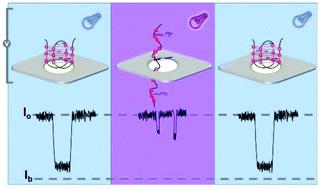Our official English website, www.x-mol.net, welcomes your feedback! (Note: you will need to create a separate account there.)
Reversible photo-regulation on the folding/unfolding of telomere G-quadruplexes with solid-state nanopores
Analyst ( IF 4.2 ) Pub Date : 2020-11-03 , DOI: 10.1039/d0an01930e Jing Tang 1, 2, 3, 4, 5 , Ji Wu 1, 2, 3, 4, 5 , Rui Zhu 4, 5, 6, 7, 8 , Zhong Wang 1, 2, 3, 4, 5 , Chuanqi Zhao 3, 5, 9, 10, 11 , Peng Tang 1, 2, 3, 4, 5 , Wanyi Xie 1, 2, 3, 4, 5 , Deqiang Wang 1, 2, 3, 4, 5 , Liyuan Liang 1, 2, 3, 4, 5
Analyst ( IF 4.2 ) Pub Date : 2020-11-03 , DOI: 10.1039/d0an01930e Jing Tang 1, 2, 3, 4, 5 , Ji Wu 1, 2, 3, 4, 5 , Rui Zhu 4, 5, 6, 7, 8 , Zhong Wang 1, 2, 3, 4, 5 , Chuanqi Zhao 3, 5, 9, 10, 11 , Peng Tang 1, 2, 3, 4, 5 , Wanyi Xie 1, 2, 3, 4, 5 , Deqiang Wang 1, 2, 3, 4, 5 , Liyuan Liang 1, 2, 3, 4, 5
Affiliation

|
The formation of G-quadruplexes (G4) in human telomere and other important biological regions inhibits the replication and transcription of DNA, thereby influencing further cell proliferation. The investigation of G4 formation and unfolding is vital for understanding their modulation in biological processes and life science. Photo regulation is a facile and sensitive approach for monitoring the structures of biomacromolecules and material surface properties. The nanopore-based technique is also prevalent for label-free single-molecule characterization with high accuracy. This study provides a combination of solid-state nanopore technology with light-switch as a platform for the modulation of human telomere G4 formation and splitting under switchable light exposure. The introduction of molecular switch, namely azobenzene moiety at different positions of the DNA sequence influences the formation and stability of G4. Three azobenzenes immobilized on each of the G-quartet plane (hTelo-3azo-p) or four azobenzenes on the same plane (hTelo-4azo-4p) of the human telomere G4 sequence realized the reversible control of G4 folding/unfolding at the temporal scale upon photo regulation, and the formation and splitting of G4 with hTelo-4azo-4p is slower and not thorough compared to that with hTelo-3azo-p due to the coplanar steric hindrance. Moreover, the G4 formation recorded with the combined nanopore and photo-responsive approach was also characterized with fluorescence, and the variation in the fluorescence intensity of the NMM and G4 complex exhibited a different tendency under reverse light irradiation due to the distinct interactions of NMM with the azobenzene-modified G4. Our study demonstrated a controllable and sensitive way for the manipulation of G4 structures, which will be inspiring for the intervention of G4-related cell senescence, cancer diagnosis and drug exploration.
中文翻译:

具有固态纳米孔的端粒G-四链体折叠/展开的可逆光调节
人端粒和其他重要生物学区域中G-四链体(G4)的形成抑制DNA的复制和转录,从而影响进一步的细胞增殖。G4形成和展开的研究对于了解它们在生物过程和生命科学中的调控至关重要。光调节是监测生物大分子的结构和材料表面特性的简便而敏感的方法。基于纳米孔的技术也普遍用于高精度的无标记单分子表征。这项研究提供了固态纳米孔技术与光开关的结合,作为调节人类端粒G4形成和在可切换曝光条件下分裂的平台。引入分子开关,即在DNA序列不同位置的偶氮苯部分影响G4的形成和稳定性。固定在人端粒G4序列的每个G四重峰平面(hTelo-3azo-p)上的三个偶氮苯或同一端粒(hTelo-4azo-4p)的四个平面上的四个偶氮苯实现了G4在时间上可折叠/展开的可逆控制由于光共平面位阻,与hTelo-3azo-p相比,hTelo-4azo-4p与G4的形成和分裂较慢且不彻底。此外,结合纳米孔和光响应方法记录的G4形成也通过荧光进行表征,NMM和G4配合物的荧光强度变化在逆光照射下表现出不同的趋势,这归因于NMM与偶氮苯修饰的G4的明显相互作用。我们的研究证明了可操纵和敏感的方式来操纵G4结构,这将对G4相关的细胞衰老,癌症诊断和药物探索的干预产生启发。
更新日期:2020-11-18
中文翻译:

具有固态纳米孔的端粒G-四链体折叠/展开的可逆光调节
人端粒和其他重要生物学区域中G-四链体(G4)的形成抑制DNA的复制和转录,从而影响进一步的细胞增殖。G4形成和展开的研究对于了解它们在生物过程和生命科学中的调控至关重要。光调节是监测生物大分子的结构和材料表面特性的简便而敏感的方法。基于纳米孔的技术也普遍用于高精度的无标记单分子表征。这项研究提供了固态纳米孔技术与光开关的结合,作为调节人类端粒G4形成和在可切换曝光条件下分裂的平台。引入分子开关,即在DNA序列不同位置的偶氮苯部分影响G4的形成和稳定性。固定在人端粒G4序列的每个G四重峰平面(hTelo-3azo-p)上的三个偶氮苯或同一端粒(hTelo-4azo-4p)的四个平面上的四个偶氮苯实现了G4在时间上可折叠/展开的可逆控制由于光共平面位阻,与hTelo-3azo-p相比,hTelo-4azo-4p与G4的形成和分裂较慢且不彻底。此外,结合纳米孔和光响应方法记录的G4形成也通过荧光进行表征,NMM和G4配合物的荧光强度变化在逆光照射下表现出不同的趋势,这归因于NMM与偶氮苯修饰的G4的明显相互作用。我们的研究证明了可操纵和敏感的方式来操纵G4结构,这将对G4相关的细胞衰老,癌症诊断和药物探索的干预产生启发。



























 京公网安备 11010802027423号
京公网安备 11010802027423号